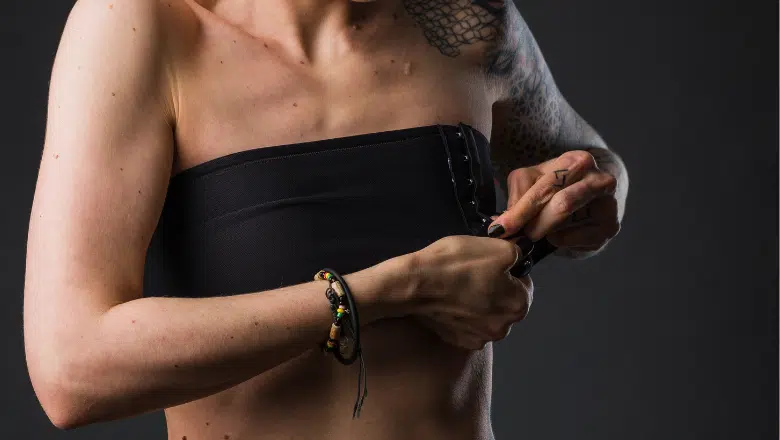Affirming one’s identity via physical manifestation is an essential stride on the path of self-expression and acceptance, and chest binding provides an empowering avenue to address dysphoric feelings associated with an incongruent chest presentation. As a practical and non-invasive approach, chest binding paves the way towards confidence and comfort within one’s own body, serving as a precursor for those contemplating more permanent measures, such as FTM (female-to-male) top surgery procedures.
If you’re considering this significant step, yet find yourself marinating in contemplation, reflecting on the timing or sifting through the numerous options for top surgery in London, we can help you navigate through the uncertainties.
At Centre for Surgery, we pride ourselves as the premier institution for gender affirmation surgery in London. Located in our Baker Street clinic, our seasoned team of surgeons, adept in the art of gender transition procedures, perform a multitude of FTM top surgeries each year. Our unwavering dedication towards patient-centred care has earned us our status as leaders in this field.
Being aware of the physical and emotional challenges accompanying the path to gender alignment, we ensure that each individual receives a customised care plan to match their unique needs. Our philosophy is grounded in trust, respect, and confidentiality, providing a safe and welcoming environment that puts patients’ comfort at the forefront.
The process of gender affirmation is a journey, one that demands support, understanding, and expert guidance. With Centre for Surgery by your side, you’ll be in the most compassionate and knowledgeable hands. We invite you to begin your journey towards the identity that feels most authentic to you, fostering a profound connection with your body and helping to forge an assertive and liberating identity expression.
What is Chest Binding?
Chest binding, at its core, is a method of breast compression utilised to flatten and obscure the presence of feminine breasts, thus enabling the presentation of a more traditionally masculine chest contour. This process, though invaluable in aiding individuals to feel more aligned with their gender identity, can, unfortunately, present potential health hazards if not implemented correctly.
Ground-breaking research spearheaded by The Binding Health Project, renowned as the sole study of chest binding to be published in a prominent medical journal, unveils the compelling dichotomy of this practice. On the one hand, it reveals the majority of participants who engage in chest binding acknowledge it as a profoundly positive practice, one that significantly assists in their emotional and psychological wellbeing. Conversely, they also attest to experiencing at least one detrimental side effect as a direct result of binding.
The range of side effects include, but are not limited to, discomfort in the back, chest, and abdominal regions, and various skin reactions such as itchiness, tenderness, swelling, rashes, and chafing. Some individuals reported experiencing shortness of breath, overheating, and chest pain. Additionally, changes in posture were reported as a common consequence of regular chest binding.
The qualitative analysis of the study further highlighted a concerning statistic – almost half of the participants surveyed confessed to believing that they had incurred rib fractures due to their binding practices. This stark revelation underscores the paramount importance of learning and implementing safe binding techniques, to ensure that this vital method of identity expression does not compromise one’s physical health.
Dangers of Chest Binding
The advent of DIY chest binding is far from a novel occurrence. It is particularly prevalent among teenagers and adults who are yet to embark on, or are unable to access, FTM top surgery in London. Often born out of necessity or resourcefulness, DIY binding frequently entails the wrapping of the chest using an array of readily available household materials, including:
- Plastic wrap
- Duct tape
- Ace bandages
- Stockings
Unfortunately, these makeshift binders can often wreak havoc on the skin due to their abrasive nature. They do not allow for necessary considerations like breathing, movement, or adequate air circulation, making them potential hazards.
Another prevalent DIY chest binding method, the so-called “sports bra method”, involves wearing two constrictive sports bras simultaneously, one on top of the other. Whilst this may initially seem like a safer alternative, it can prove to be exceptionally restrictive and hence uncomfortable. This may lead to problems such as difficulty breathing, thus emphasizing the potential pitfalls of DIY binding.
The inherent risks associated with these DIY binding practices highlight the urgent need for accessible, affordable, and safe binding solutions for all those seeking to reduce the prominence of their chests. This is crucial to ensuring the health and well-being of those on their journey towards aligning their physical bodies with their gender identity.
Choosing the best chest binder
Finding the perfect chest binder hinges on prioritising safety, comfort, and effective compression. There is a plethora of chest binding styles available on the market, each catering to diverse body types and lifestyles. You may need to experiment with different styles to determine the one most compatible with your individual needs and circumstances.
Here are some of the more common chest binder styles:
- Long shirt – This is a full upper body binder that can be tucked into your trousers, providing comprehensive compression across both the chest and stomach area.
- Vest binder – Characterised by a zippered front closure, this binder offers ease of use, ensuring you can put it on and take it off without much struggle.
- Compression sports bra – Designed with chest compression in mind, this resembles a conventional sports bra but has the added functionality of aiding in chest minimisation.
Choosing the perfect chest binder is as much about the right fit as it is about the style. It’s crucial to resist the temptation to opt for a smaller size to increase compression. This is a common pitfall that can lead to significant discomfort and health risks.
A well-fitting chest binder should allow you to breathe freely, move naturally, and promote air circulation. Additionally, choosing a binder made from a soft, breathable material will ensure you can wear it for extended periods without undue discomfort. Always remember, the aim of binding is not just about the physical change, but equally about maintaining your health and comfort while affirming your gender identity.
How Long Can You Wear Your Chest Binder?
Wearing a chest binder for the appropriate duration is imperative to maintain one’s health and well-being. As chest binders exert pressure on the ribcage, skin, and underlying tissues, it is essential to be mindful of the time spent wearing them to minimize the risk of complications such as skin irritation, breathing difficulties, or musculoskeletal issues.
Here are some general guidelines on how long you can wear a chest binder:
- Ease into It: If you are new to chest binding, it is advisable to start slowly. Wear the binder for a few hours initially and gradually increase the duration over several days or weeks as you become accustomed to the feeling.
- Daily Limit: As a general rule, it is recommended not to wear a chest binder for more than 8 to 12 hours a day. However, this may vary based on individual comfort levels and the binder’s material and fit.
- Take Breaks: It is essential to give your body regular breaks from binding. This can be achieved by taking the binder off for short periods throughout the day or designating certain days as non-binding days to allow your body to recover.
- Listen to Your Body: Pay attention to how your body feels. If you experience pain, difficulty breathing, or any signs of skin irritation, it is vital to remove the binder immediately. These symptoms can be indicative that the binder is too tight or that it’s being worn for too long.
- Nighttime: It is highly recommended not to wear a binder while sleeping. Your body needs to be able to move freely and breathe without restriction during sleep.
- Exercise: Be cautious about wearing a binder during physical activity. If you must wear one while exercising, ensure it’s a looser fit and made of breathable material. Still, it’s generally better to wear a sports bra or a specialized compression top designed for exercise.
Reduce chest binding in the run-up to FTM Top surgery
If you are contemplating or have already scheduled an FTM top surgery, it is prudent to moderate your chest binding practices in the lead-up to the procedure. Diminishing the frequency and duration of binding can be beneficial for several reasons:
- Optimising Skin Elasticity: Constant binding can affect the skin’s elasticity over time. By binding less, you give your skin the opportunity to regain some of its natural elasticity, which can be crucial for the healing process and final appearance post-surgery.
- Improving Circulation: Binding can restrict blood flow to the chest area. In preparation for surgery, it’s important to have optimal blood circulation to promote healing and reduce the risk of complications.
- Alleviating Pressure on the Ribcage: Constant pressure on the ribcage from binding can affect the muscles and bones in the area. Reducing binding before surgery can help mitigate any inflammation or strain, ensuring that your body is in the best possible condition for the procedure.
- Assessing Preoperative State: Giving your chest some time without binding can help both you and your surgeon to assess the preoperative state of the area more accurately. This can be important for surgical planning and setting realistic expectations for the outcome.
- Mental Preparation: Reducing binding in anticipation of the surgery can also be a mental and emotional preparation, helping you to embrace the upcoming change and concentrate on the steps needed for a successful transition.
Given the significance of FTM top surgery in one’s gender-affirming journey, it is imperative to approach the procedure with the utmost care for one’s physical well-being. Engage in open dialogue with your healthcare provider and follow the guidelines provided by your surgeon. This, combined with a mindful approach to binding in the weeks leading up to the surgery, will position you for the best possible outcomes both in terms of healing and in achieving the chest contour that aligns with your gender identity.
RELATED: Recovery after FTM Top Surgery – Top Tips after Breast Removal Surgery
Learn More About Top Surgery London
If the prospect of undergoing FTM top surgery in London has been persistently occupying your thoughts, yet you find yourself ensnared by hesitation or seeking further clarity, we at Centre for Surgery extend a warm invitation for you to visit our esteemed clinic. We regard it as a privilege to accompany individuals on their deeply personal journeys towards self-realisation and congruence in their gender expression.
RELATED: How to Minimise Scars after FTM Top Surgery
Our clinic, a haven of comfort and privacy situated on the iconic Baker Street, is home to an unparalleled team of surgeons, who are not only exceptionally skilled but also empathetic and understanding. Our top surgery London specialists are dedicated to providing you with comprehensive medical guidance tailored to your unique circumstances and aspirations.
By booking an in-person consultation with us, you will be affording yourself the opportunity to explore the full spectrum of transition-related surgery options, and address any questions or concerns in an environment that upholds the utmost respect and confidentiality. Our unwavering commitment to patient-centred care ensures that you will be guided with compassion, expertise, and understanding.
Take that pivotal first step in the tapestry of your transition. Connect with us at Centre for Surgery on 0207 993 4849 to carve a path that is reflective of your truest self. Schedule an in-person consultation at our Baker Street clinic, and let’s embark on this transformative journey together.
RELATED: How Much does MTF & FTM Top Surgery Cost In London?










